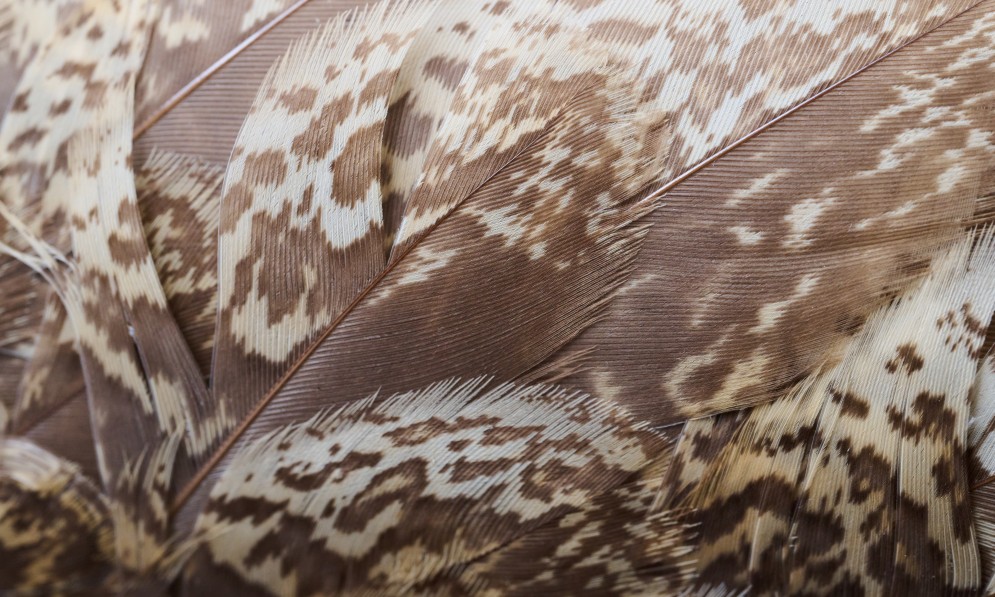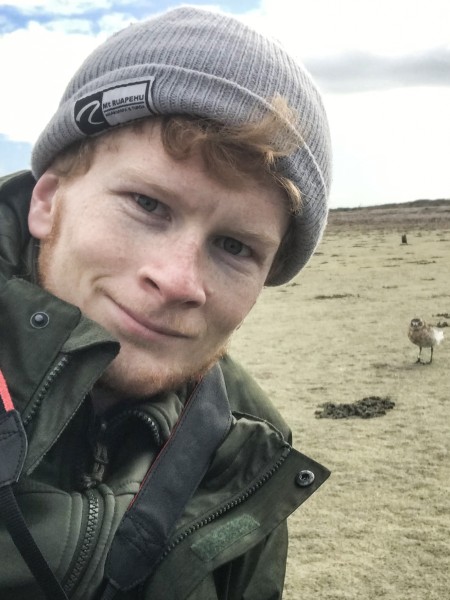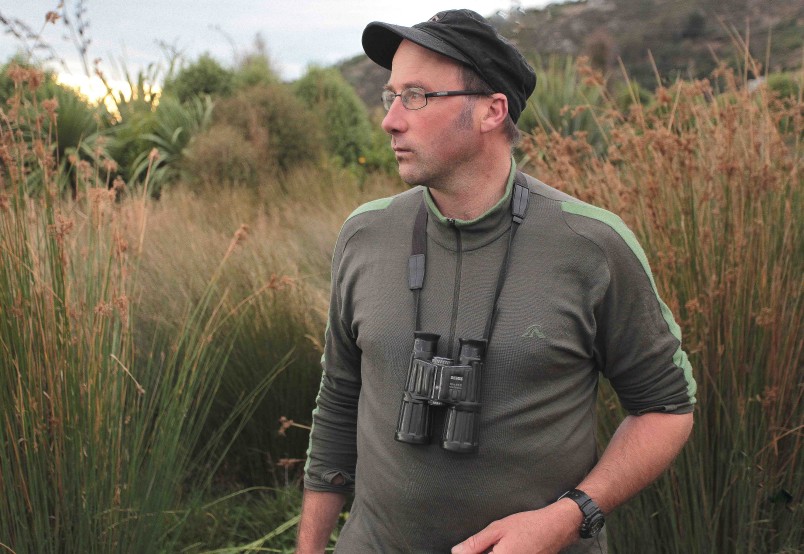By Peter Langlands
Forest & Bird magazine
A version of this story was first published in the Winter 2024 issue of Forest & Bird magazine.
Seeing an Australasian bittern is always memorable. The birds are large, with a striking plumage and a dagger-like beak. They erupt from reedbeds like a jack-in-the-box and are rarely seen out in the open.
Matuku-hūrepo are important to Māori and appear in many of their stories, pictures, and place names. There is something otherworldly about them, a sense they are out of place in our rapidly changing world.
With fewer than 1000 bitterns left in Aotearoa New Zealand, conservationists are worried about their future. Habitat loss, disturbance, and predators are their biggest threats.
Bitterns have a distinctive booming call but otherwise live cryptic and secretive lives, making them difficult to find and study, although satellite tracking, drones, and trail cameras are providing new insights.
Here five bittern conservationists share their personal encounters with matuku-hūrepo and outline the practical measures needed to aid their recovery. All of them are determined to stop the last of our iconic wetland “boomers” from vanishing forever.
JOHN SUMICH | MATUKU LINK TRUSTEE, AUCKLAND

John Sumich, Te Henga wetland.
Although interested in birds from primary school age, I was rather a passive birder, enjoying seeing them here or overseas without being a hard core twitcher. My first bittern encounter occurred while training for a marathon, and I was taking a long run at Okiwi on Great Barrier Island. Out of the corner of my eye, I saw, in the wetland below the road, a bird I recognised from books as a bittern. Stopping abruptly, I looked at the bird, it looked at me, and it gave way first, melting into the reeds.
Another 25 years went by, by which time I was chair of the wetland committee of our Forest & Bird branch. As I developed a trapping regime in the greater area to prepare for a pāteke translocation, I started to see bittern more often at our Matuku Reserve. From my involvement with drones for tracking pāteke, I conceived the idea of using drones with thermal cameras to detect bittern, which was trialled with Emma Williams, of the Department of Conservation, in 2016 in the eastern Bay of Plenty.
It was known the species was in decline, but how many bittern were there, I wondered. In 2021, I set up a nationwide survey – “OK Boomer” – to gather a different metric of male bitterns heard booming during the breeding season as a way to gauge populations in different wetlands. Observations and data were being gathered by individuals and community groups interested in matuku-hūrepo, as well as councils and DOC, but there was no central collation of this information.
Rallying several folk who were involved in serious monitoring of, and pest control for, bittern and other wetland species resulted in us forming the Bittern Conservation Trust. Its aims are to raise awareness of bittern, to use consistent monitoring techniques, and to help groups or individuals connect with regional or national bodies.
The Bittern Conservation Trust
WENDY AMBURY | LOVE BITTERN PROJECT, NORTHLAND

Bittern feathers. Image Craig McKenzie
When I was a child growing up in rural New Zealand, I loved to play in the swamps, making hides on floating platforms of reeds, and scaring my siblings and their friends away by telling them the strange noise we heard was a swamp monster. I didn’t know what the noise was myself at the time and never connected it to the boom of the bittern until years later. Now, over four decades later, Australasian bittern are Critically Endangered – one step away from extinction. I feel like, if we don’t do something now to help bittern, the next generation may not hear the extraordinary boom of a male bittern or catch a fleeting glimpse of this cryptic, prehistoric-looking bird, and if I don’t do something who will?
A key component of the Love Bittern Project is travelling around the country to meet with community groups and help them advocate for bittern. I do this by having a conversation with them, listening to what they know, and sharing what I know about tools that can be used to record and protect bittern, as well as their wetland habitats. In this way, we grow our collective knowledge. Behind the scenes, I help by developing and providing resources for community groups to use, such as customising The Conservation Hub app for recording observations and monitoring records, informative handouts they can use at events, guides on how to record and monitor bittern, children’s activities, and social media packs.
Backing bittern isn’t an easy thing to do when a lot of people don’t even know they exist in the first place! The lights really go on when people realise that bittern are near the top of the food chain in a wetland, and if we look after bittern there is a whole wetland ecosystem we are protecting as well … everything from tuna eels, fish, frogs, insects, invertebrates, plants, water, and ultimately us too. Everything is connected. By galvanising our communities to come together as one to treasure bittern and their wetland habitats, we might just save the species and along the way renew our relationship with water, be better connected as people, and build more resilient communities.
Doing nothing is not an option.
CRAIG PAULING (NGĀI TAHU AND NGĀTI MUTUNGA) | CANTERBURY REGIONAL COUNCILLOR
My awareness of kautuku (another Māori name for bittern) was first sparked by seeing a fantastic photo by Imogen Warren of a bittern with a small tuna eel curled around its beak, standing in front of raupō and realising the special connection of these species. This awareness was heightened through my work on the management plan for Tārerekautuku or Yarrs Lagoon and understanding the significance of that place for bittern and for my Ngāi Tahu tupuna. I was also already working on the restoration of Ahuriri Lagoon and noted the potential for it to provide habitat for kautuku.
My first real life encounter with a kautuku was very recently, when I went out to Ahuriri Lagoon, on the Huritini Halswell River, with Peter Langlands. It was a beautiful calm early Monday morning, and we were visiting a wetland area I had helped get re-established through a project led by the Whakaora Te Waihora partnership. I had contacted Peter a few weeks earlier after reading his posts about bittern surveys across Canterbury and offered to help. It wasn’t until nearly completing our circumnavigation of the wetland that we flushed out a single adult from a clump of raupō. It was magical to see it jump up, flap its wings, and veer off towards Te Waihora. We also saw a pair of pūweto spotless crake, and it was fulfilling to know the work we had done on the wetland – a paddock only five years ago – was now home to these two species.
So, for me, kautuku are a symbol of the interconnectedness of a functional wetland ecosystem – of the raupō, the tuna, and the kautuku all needing each other to thrive. They exemplify the mauri or lifeforce of wetlands and of the important role wetlands have in our world. These are essential elements of our natural environment, and it is my goal to ensure they always maintain their place alongside us. That is why I will continue my work in advocating for restoration across Canterbury and, in particular, the restoration of wetlands around Te Waihora, a key action for both Te Waihora and the species that live there, including kautuku.
Bittern captured on trail camera checking out a raised wetland walkway, Kopuatai, Hauraki Plains. Image Rachel Langman/DOC
KEN HUGHEY | CONSERVATION SCIENTIST, LINCOLN UNIVERSITY, CANTERBURY
I n the 1980s, I worked for the Wildlife Service (precursor to the Department of Conservation) and coordinated monthly bird surveys of Te Waihora Lake Ellesmere. In those days, we often did entire sections by ourselves, and one freezing cold day I was surveying the Selwyn to the Ararira. I encountered five matuku-hūrepo bitterns. It was incredible, and to this day I have never seen that many in one day again. I have always loved them, yet increasingly they are struggling to survive.
During my time with Te Papa Atawhai DOC, I continued to have periodic involvement with matukuhūrepo-related issues. Now, in semi-retirement, I’m heavily involved with the Waihora Ellesmere Trust, and bitterns’ needs are even closer to my heart. To me, the matuku-hūrepo is the canary in the coal mine for our diminishing wetlands and their values. I am convinced that if we get it right for bittern then we will get it right for many of our wetlands, not all but many.
What all this means to me is that we need to stop tinkering and “think big” for matuku-hūrepo and wetlands more generally. To do this, we will need to grow wetlands and effectively farm bittern into recovery. This is happening in rice field areas of southern New South Wales, and, if we value the species, we can do the same here. Everybody will gain from such an approach. I drafted a proposal that I have presented to Environment Canterbury via one of its councillors, and I look forward to it being discussed and implemented through the Canterbury Water Management Strategy and the Council’s long-term plan. If we don’t do this, it will likely consign matuku-hūrepo bittern to extinction in Canterbury.
OSCAR THOMAS | BIRD WRITER AND PHOTOGRAPHER, DUNEDIN

My first encounter with a matuku-hūrepo was a stuffed one at Te Papa when I was 10, but four years later I found one living and breathing in one of its strongholds, the Whangamarino Wetland, an hour south of Auckland. On arriving, we were greeted with a vast expanse, a mosaic of ponds, bogs, scrub, reeds, and willows. Not having a telescope to spot bitterns, I headed down into it, and soon the vegetation opened out onto a small puddle of water and there was a bittern standing stoically on the edge of it. Within seconds, it had vanished, flying deeper into the wetland. Later that same day, I was able to appreciate one properly at Hamilton Zoo, whose staff were looking after a rescue bittern unable to survive in the wild after being shot by duck hunters.
A cryptic wetland specialist, the Australasian bittern was once one of Aotearoa’s most common bird species. Now, with more than 90% of our wetlands drained and destroyed, they are one of our most threatened. When I was 16, I returned to Whangamarino Wetland as a field assistant for Dr Emma Williams, Aotearoa’s top bittern expert. We spent two seasons there counting and triangulating booms (the deep resonant mating call of a male bittern, audible for up to 2km), and creating vegetation plots around bittern sightings to see what type of plants they associate with. Cage traps accompanied by a mirror and boom recordings caught the attention of the territorial males, thinking another bittern was on their turf. This way, Emma was able to catch and tag birds to get an idea of their movements throughout the year.
Little did we know, bitterns sometimes migrate half the length of the country and can be incredibly mobile outside of the nesting season. The dark shadow cast by this reveal is that we may be double counting bitterns when estimating the national population, meaning they are even rarer than we could have anticipated. The unfortunate truth is that Australasian bitterns do not have the capacity to adapt to the rapidly changing natural environment in Aotearoa, unlike species such as the matuku moana white-faced heron. What they need most is wetland protection and wetland restoration, large swathes of quality suitable habitat that is both safe to nest in and bountiful to feed in. As such, we must do what we can to help them.
OK BOOMERS!
I feel privileged to have interviewed these five people about bitterns and their conservation. Their passion for this species – a symbol of the wilderness element of our wetlands – gives me hope that bittern can be saved. With the formation of a National Bittern Trust, as John Sumich outlined, I feel there is now a strong human voice to boom alongside that of the bittern.
As Wendy Ambury pointed out, we need to make more people aware of bitterns’ existence in Aotearoa, as the species has lacked some of the profile given to other critically endangered birds. In many ways, the booming bittern is the “kākāpō of our wetlands” and an important indicator for ecological health of a wetland.
The clock is ticking, and, as Ken Hughey explained, large-scale habitat creation is critical for bitterns’ survival and that of many associated wetland species. Craig Pauling is a man of action and was pivotal in the creation of a large Canterbury wetland that has subsequently attracted breeding bittern. He has ambitions for the wetland area to expanded to become eight times it current size.
Oscar Thomas’s passion for research and his hands on conservation with leading DOC scientists is also an essential part of the equation. Learning about the bittern’s high level of mobility shows we need to look at bittern conservation on a landscape scale.
Certainly, the time is now to move forward with bittern conservation, and once you have been “bitten by the bittern bug” there is no way of going back, for the fascination with this bird will continue as a lifelong interest.

Peter Langlands is a marine and freshwater conservationist, writer, photographer, and author of Foraging New Zealand. He is involved with matuku-hūrepo research and is a trustee on the recently formed Bittern Conservation Trust.

